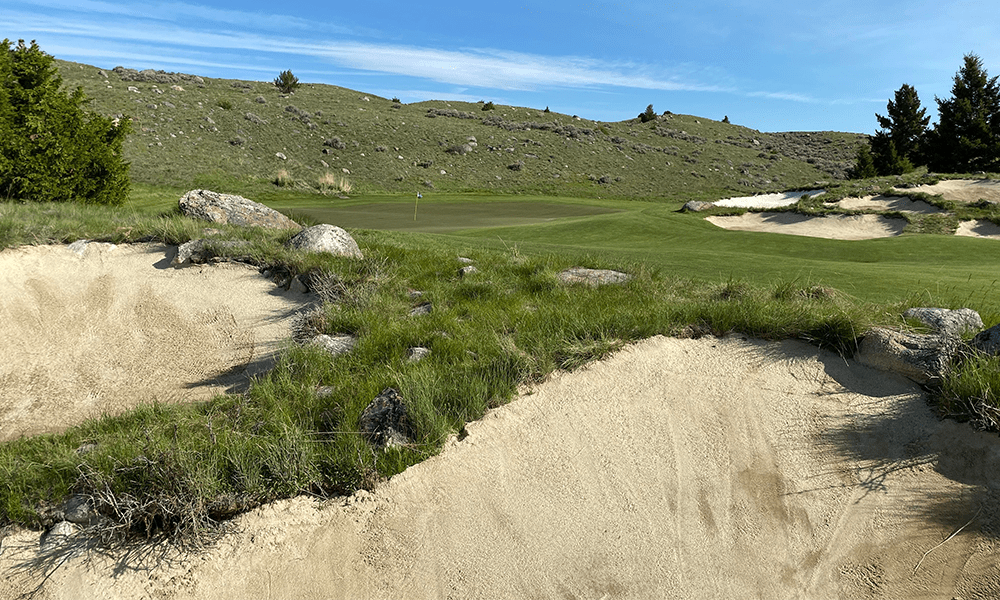Superintendent Solves Elk damage at Course with Bunker Liners


Elk Damage at Rock Creek
Elk getting into bunkers has resulted in damage to them at Rock Creek Cattle Company in Montana, designed by architect Tom Doak. But lining the bunkers with the Capillary Bunker system is set to solve the problem.
“When the course was built, the bunkers were lined with a textile product,” says course superintendent Rick Hathaway. “Given the location, some sort of liner was essential. The clue is in the name: the soil here is full of rocks, from pebbles to big granite boulders. With frost heaves in winter, the rocks move up through the profile, and would penetrate unlined bunkers very easily.”
But the textile liner could not cope with another problem caused by Rock Creek’s location – wildlife. “We have a large herd of resident elk, about a thousand strong. And they really like our bunkers!” says Hathaway. “Their natural position is head up, so if they are down in a bunker, they have grass at head height. So it makes eating less work for them. Especially in the fall, when they come back out of the mountains, the elk spend a disproportionate amount of time in the bunkers. And they are big, heavy animals. Their hooves inevitably cause damage to a fabric liner, and once there is a little hole, the sand gets through and the situation starts to deteriorate. It got to the point where we couldn’t manage the amount of damage that was happening. I was using six or seven guys two days a week working on liners.”
And elk are not the only wildlife that caused Hathaway sleepless nights. “We have a lot of ground squirrels here and they burrow up through the bunkers. Then the badgers – which want to eat the ground squirrels – dig down after them, and the next morning we have huge holes in our bunkers,” he explains. “A couple of years ago, I went to my greens committee chairman – a committee of one! – and he asked me what keeps me awake at night. I told him and said ‘Let’s start thinking about redoing one day’. The course is a masterpiece and the bunkers weren’t doing it any favors. From a distance, they looked pretty but from a playability point of view, they weren’t as good as the rest of the course. A couple of weeks later, he called me and said ‘It’s a go’.”
“I met the Capillary Bunkers rep and started having conversations with him, and I gave a couple of local superintendents a call. I went over to one that was doing a very large renovation of the course and went out for a day and watched them install the product. That gave me confidence in how it is installed and works. Last year, my greens chairman and I made the decision that Capillary Bunkers was the right choice. We did three test bunkers, evaluated different bunker sands, and made our decision.”
The project began in April, with construction being handled by contractor Ridgetop Golf, from Seattle, and the last bunkers were lined at the beginning of June. “We typically open the golf course on May 15, and April is the month I count on getting major course work done, so for the first six weeks of construction, there were no golfers around,” says Hathaway. “When we excavated the bunkers, I had the contractor scrape an inch or two out of the subgrade to make sure we didn’t change the depth.”
Hathaway is delighted with the results. “The bunkers are spectacular,” he says. “We have these jagged faces that have eroded in the thirteen years the course has been open, and that gives them even more character. There’s a little lip and the concrete fits in there. You’d never know there was concrete there.” Hopefully, the elk will concur!
At the core of our solution, Capillary Bunkers is a patented and engineered polymer-based concrete. It is the only building material that can rapidly drain water while also moving water up. Capillary Bunkers’ cutting-edge, patented technology helps you control water in any climate, season, and soil type, providing better, more consistent playing experiences while reducing costs. http://www.capillaryconcrete.com
Capillary Bunkers is recognized as the world’s leading and most advanced bunker liner, and the most durable bunker construction method. It allows water to flow through the base of the bunker while keeping sand on the faces and preventing washouts, keeping bunkers in perfect shape during any weather condition. Over 800 courses around the world have built or renovated their bunkers with Capillary Concrete, including dozens of golf’s top 100 courses.
Recent Posts
Five Cabot Golf Courses Place in Golfweek’s Prestigious 2025 Top 100 International Courses List
Cabot, a developer and operator of luxury resort and residential golf destinations, is proud to…
Champion Hills Rebuilds with Heart: A Story of Resilience and Restoration
When Hurricane Helene swept through in late September 2024, Champion Hills Golf Club faced a…
Discover the New Graves Golf Club: A Game-Changing Facility in Edmond, OK
Graves Golf Club, the much-anticipated golf and training destination founded by celebrated instructors Tim and…
Circling Raven Named Idaho’s Top Public Course by GOLF Magazine
The ratings are in and expert panelists for GOLF Magazine (golf.com) rank Circling Raven Golf…
Q&A with a Multi-talented Golf Course Architect – Part 1: Making the Rounds – Installment 38
This column features recollections of the author’s 37 years as a golf writer. These installments…
Ortmeier, Tingen receive Grassroots Ambassador Leadership Awards from GCSAA
Chris Ortmeier, director of agronomy at Champions Golf Club in Houston, Texas, and Clinton Tingen,…


